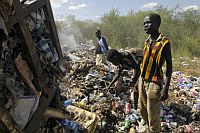Thursday, April 18, 2024
News and Views from the Global South
DEVELOPMENT: A Billion Hungry People Need Rescue Plan Too
Wolfgang Kerler
- Relief for the world’s hungry remains a distant prospect, with this year’s “Global Hunger Index” (GHI) attesting that even before the ongoing food crisis, 33 countries had “alarming” or “extremely alarming” levels of hunger.

Sudanese youth scavenge for food and clothing in a municipal garbage dump in Juba on Sep. 4, 2008. Credit: UN Photo/Tim McKulka
“Although we found several success stories, there was no across-the-board success,” Marion Aberle, a spokesperson for Welthungerhilfe (formerly known as German Agro-Action), told IPS about the recent GHI.
She added that “it is simply a scandal that almost one billion people worldwide are still suffering from hunger.”
Together with the International Food Policy Research Institute (IFPRI) and Concern Worldwide, on Tuesday Welthungerhilfe launched GHI 2008, an index ranking 88 developing and transitional countries using the most recent available data from 2001 to 2006.
“The rankings do not reflect the current crisis of rising food prices, but they do highlight which countries could be most vulnerable to the crisis,” IFPRI said in a statement released simultaneously with the GHI.
The dramatic rise of food prices since 2006 has marked a major setback in the fight against malnutrition, as the countries most severely affected by hunger overwhelmingly are net-importers of cereals and other food.
“Although their agricultural sectors have the potential to feed their population,” Aberle added.
She stressed that “the only way to effectively eradicate hunger is to boost agricultural production in developing countries”. Additionally, an increase in food aid was needed for those who are currently hungry.
Three leading indicators – the proportion of undernourished, the prevalence of underweight children under five, and the under-five mortality rate – are combined into the GHI with a 100-point scale, 0 and 100 being best and worse, respectively.
Overall, the GHI fell by almost a fifth from 18.7 in 1990 to 15.2 in 2008, mostly due to progress in children’s nutrition. Improvement was scant in under-five mortality and the proportion of undernourished.
“The world has made only slow progress in reducing hunger in past decades, with dramatic differences among countries and regions,” said Joachim von Braun, IFPRI director general.
While the GHI decreased by almost 40 percent in Latin America, by about 30 percent in Southeast Asia and about 25 percent in South Asia, it shrunk by only 11 percent in Sub-Saharan Africa.
“Deterioration has been most dramatic in the Democratic Republic of Congo (DRC),” Aberle said. With a GHI of 42.7 – up from 25.5 in 1990 – the country is now scoring worst.
In DRC, all common characteristics for states heavily affected by hunger can be found: war, violent conflict and political instability, high prevalence of HIV/AIDS, inequality and a lack of general freedom.
Other countries with “extremely alarming” levels of hunger (a GHI over 30 points) are Eritrea, Burundi, Niger, Sierra Leone, Liberia and Ethiopia.
With the exception of Haiti, the 26 countries with an “alarming” level of hunger – described as a GHI between 20 and 29.9 – are all located in Sub-Saharan Africa, South and Southeast Asia.
As regions, Sub-Saharan Africa and South Asia are scoring worst on the 2008 GHI, with 23.3 and 23.0 respectively.
The most success could be seen in Kuwait and Peru: Both countries have managed to decrease their GHI by about 70 percent – “examples showing that progress is possible”, said Aberle.
Since 1990, only a handful of countries made significant progress. About a third of the countries made modest progress – defined as a reduction of GHI between 25 and 50 percent.
Among those countries is India, whose GHI declined from 32.5 in 1990 to 23.7 in 2008 – ranking 66 on the GHI. With more than 200 million people, India is home to over one-fifth of the world’s hungry – hence, IFPRI decided to produce an India State Hunger Index (ISHI).
“We felt it was time to develop an India-specific index, but also one that would be comparable with the GHI,” Purnima Menon, a research fellow at IFPRI, told IPS.
The ISHI 2008 scores for the 17 major states in India whose hunger levels were calculated range from 13.6 for Punjab to 30.9 for Madhya Pradesh – showing that not a single state falls in the “low hunger” or “moderate hunger” categories, and representing the substantial differences between the regions.
In almost all the states, underweight children contribute most to the ISHI – but there are some where calorie deficiency has the largest contribution.
“The other interesting comparisons are the links between economic indicators and the hunger index,” Menon said. “Not all states that have high economic growth are doing well on hunger.”
To eradicate hunger in India, similar actions are needed: strengthening of agriculture, social protection, poverty reduction and the distribution of essential nutrition and health interventions to women and children in the period of pregnancy and the first two years of life.
Referring to the hundreds of billions of dollars being spent to solve the current financial crisis, Aberle from Welthungerhilfe said: “We would love to see similarly strong-willed action to fight the world food crisis.”

 Print
Print



